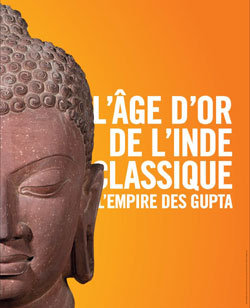The Gupta Empire
dal 4/4/2007 al 24/6/2007
Segnalato da
4/4/2007
The Gupta Empire
Galeries nationales du Grand Palais, Paris
The Golden Age of Classical India

The Golden Age of Classical India
The Gupta era (4 - 6 AD) marks the high point of Indian civilisation. During this golden age, when religious thinking, sciences, literature and the theatre flourished, art reached an unprecedented level of refinement and perfection ; aesthetic canons and iconographic models developed during the Gupta period would endure through the centuries, and their influence would spread into the art of Nepal, of South East Asia and even of Central Asia.
Thanks to exceptional loans from the greatest Indian museums, a collection of about 110 sculptures (stone, terracotta, bronze) sets out the genesis, development and the influence of this art which is still relatively unknown by the Western public. This exhibition is the first event, devoted exclusively to the art of Gupta India, to be organised in France and indeed in Europe.
As with the sovereigns of the first great historic dynasty of the Indian sub-continent, the Mauryas (4 – 2 BC), the Guptas originated from Northern India. And like other royal families in Indian history whose ancestry remains somewhat obscure, Gupta rule established itself progressively after the break-up of the great Kushana empire towards the end of the third century. Their territories extended into part of the modern state of Bihar, with the ancient city of Pataliputra (modern Patna) as the capital. The dynasty was officially founded in 319-320 by Chandragupta I, who that year ascended to the throne of a small kingdom which was to have a dazzling future. The military power and political skill of the two great sovereigns Samudragupta (around 335 – 375) and Chandragupta II (around 375 - 415) took the empire to its height before, towards the end of the fifth century, its dominance was weakened by the invasions of the Hephalite Huns, and the empire plunged into an irreversible decline.
The exhibition is laid out chronologically and presents Gupta art from the great centres of creation in Mathura and Sarnath to the most important artistic centres in outer regions of the empire which, at its height, extended over the whole of Northern India. At the beginning of the exhibition, a collection of gold coins, among the finest examples in Indian numismatics, evokes the reigns and the personalities of the greatest monarchs of the dynasty.
There is then a small group of sculptures illustrating the stylistic and iconographic antecedents from which Gupta art developed, and which are firmly rooted in the robust and profoundly eclectic art of the great Kushana period (1st-3rd centuries AD).
Mathura and Sarnath, the great artistic centres of the 5th century, are then conjured up through a stunning collection of sculptures – Buddhist, Jain and Hindu. Carved in the pink sandstone of Mathura or the buff sandstone of Sarnath, these divine images, vibrant with interiority and contained spirituality, imbued with grace and haughty elegance, with both gentle and refined contours, are the quintessence of the Gupta artistic genius and an aesthetic canon which many subsequent artistic trends down the centuries will claim to express. In addition, a variety of architectural, decorative pieces evoke the settings within Hindu shrines and Buddhist monasteries in which these works of sacred art took their place.
Often part of the temple decoration, the Gupta terracotta figures captivate us with their freshness and narrative eloquence, enhanced by superb craftsmanship. They illustrate a secular and spontaneous creativeness, whose repertoire borrows equally from theatre, mythology or from scenes of daily life, and offers an appealing counterpoint to the hieratic and grandiose cult images. The last part of the exhibition introduces art from a few great regional sites –such as Bhumârâ, Deogarh, Nachna, Kuthara and Shamalaji – and enables us to comprehend all the diversity and regional specialities of the Gupta aesthetic in the 5th and 6th centuries.
Galeries nationales du Grand Palais
Place Clemenceau - Paris
Open daily except Tuesdays from 10am to 8pm and 10am to 10pm on Wednesdays.
Admission: €10; Concessions, €8



